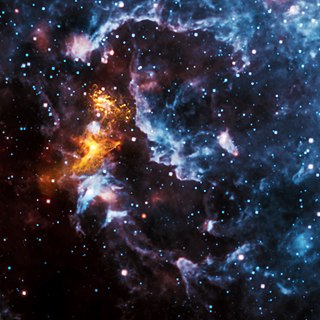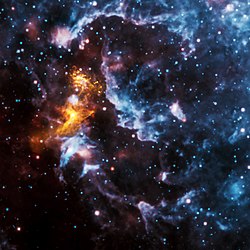Top Qs
Timeline
Chat
Perspective
PSR B1509−58
Pulsar in the constellation Circinus From Wikipedia, the free encyclopedia
Remove ads
PSR B1509−58 is a pulsar approximately at a distance of 17,000 light-years in the constellation of Circinus discovered by the Einstein X-Ray Observatory in 1982.[2] Its diameter is only 12 miles (19 km). It is located in a Pulsar wind nebula created by itself, that was caused as a remnant of the Supernova (SNR) MSH 15−52 visual approximately 1,700 years ago at the southern celestial hemisphere not visible in the Northern Hemisphere.[3][4] The nebula spans about 150 light years.[5] The 0.1515 second pulsations ("6.597 times per second") are detected in the radio, X-ray, and γ-ray bands.[6]
NASA described the star as "a rapidly spinning neutron star which is spewing energy out into the space around it to create complex and intriguing structures, including one that resembles a large cosmic hand".[7] It is also known by the name "Hand of God".[8] This phenomenon is called pareidolia.

Remove ads
Gallery
- Sequence of images of optical, X-ray, radio, and infra-red emission
- Tour of PSR B1509−58.
- Sequence of PSR B1509−58 images.
- Size comparisons: PSR B1509−58 and Crab Nebula.
- To track this motion, Chandra data is shown, from 2004, 2008, and then a combined image from observations taken in late 2017 and early 2018. These three epochs are shown in the inset of the main graphic.
See also
References
External links
Wikiwand - on
Seamless Wikipedia browsing. On steroids.
Remove ads



